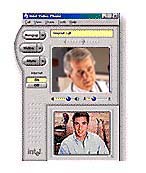Introduction to Telemedicine
This introduction to telemedicine is based on a presentation
given by Dr. Susan Zollo, Director of the Telemedicine Resource
Center at the University of Iowa. Contact susan-zollo@uiowa.edu
The Institute of Medicine defines telemedicine as "...the
use of electronic information and communications technologies
to provide and support health care when distance separates the
participants..."
The most common applications today are in transmission of high-resolution
X-rays, cardiology, orthopedics, dermatology and psychiatry.
Often, interactive video and audio are used for patient consultations
and guidance on procedures; sometimes video briefings and records
of specific operations are kept on a network in digital form.
Groups of physicians, teachers and researchers often "meet"
across large distances. Telemedicine also embraces the management
of electronic patient records, access to libraries and databases
on the Web and on private networks,  and
extensive use of e-mail by many in the medical profession.
and
extensive use of e-mail by many in the medical profession.
Telemedicine arose originally to serve rural populations, or
any people who are geographically dispersed -- where time and
the cost of travel make access to the best medical care difficult.
Now, it is increasingly being used in mainstream medicine, to
allow doctors the world over to share expensive resources and
valuable experience.
Telemedicine is increasingly global in its reach; in 1997 there
were 188 active programs around the world, including Israel,
Chile, India, Taiwan, Japan and the USA.
The availability of telemedicine is dependent to a large degree
on telecommunications, and on high bandwidth; the field is concerned
with advanced telecomm equipment and standards, methods of increasing
effective bandwidth and network performance, costs of installation
and operation, security, confidentiality and reliability, and
with government legislation aimed at furthering progress in these
areas.
The importance of bandwidth may be seen in a simple example.
With a 28.8 Kbps dial-up connection, transmission of a standard
X-ray takes 30 minutes; with a T1 line at 1.5 Mbps it takes 30
seconds; with a high-speed DS3 circuit, it takes 1 second. Clearly,
productivity and usability of telemedicine data depends on the
availability of high bandwidth.
In the Middle East, Greenstar is demonstrating how high-quality
medical care can be brought to virtually any village, powered
by solar energy and wireless data communications. This demonstration
begins with the visit by the President of the United States to
the region in December, 1998, as part of the ongoing peace process.
Dr. Khalid Moidu, an adviser to Greenstar
on telemedicine, adds to this narrative:
The earliest example of telemedicine
was in the physiological monitoring of astronauts, through pioneering
work done by NASA. The Gemini and Apollo astronauts in the 1960's
had two-way video connections with space medical experts in Houston,
and developed a quite natural mode of interaction from orbit
that featured taking care of routine health questions and needs,
and early experiments on the effects of weightlessness.
This was followed by trials at Boston's
Logan Airport, and participation by native American reservations
in the STARPHAC program.
Telemedicine in the developed world
is really "virtual transportation." In critical situations,
the ability to keep a patient where he is and not have to stage
an emergency evacuation, with all its costs and dangers, can
be vital to the patient's survival and quality of life. But in
the developing world, telemedicine delivers access to a high
level of care where it is simply not available, at any cost.
So Greenstar, with its built-in infrastructure
of power and telecommunications, delivers the platform on which
telemedicine can exist in the developing world, and through which
knowledge and experience can be effectively diffused.
A Story of
Telemedicine in Action

In mid-November, 1998, a Russian sailor on his competition yacht
in the stormy South Atlantic 400 miles from Capetown had an accident.
Victor Yazykov had injured his arm, and it became badly infected.
He was in serious danger. Fortunately, he had satellite-based
e-mail powered by solar energy, in a small, inexpensive system
on board. Over a period of days he exchanged messages with Dr.
Daniel Carlin at the New England Medical Center, and was able
to successfully perform minor surgery on his arm by getting detailed
email instructions, encouragement and support.Yazykov survived,
and is expected to make a full recovery. "The arm getting
better," he wrote. "Very grateful to doctor."
 A
Demonstration of Telemedicine
A
Demonstration of Telemedicine
A scenario is outlined which shows, in a vivid and easily-understood
way, how advanced technology can make direct, personal medical
diagnosis and treatment available to anyone, anywhere. This involves
a two-way live video conference over a local network ibetween
a patient and a doctor, discussing a simple medical condition
of tendonitis; the patient receives diagnosis, treatment, prescription
and followup.
|
Introduction to Telemedicine This introduction to telemedicine is based on a presentation given by Dr. Susan Zollo, Director of the Telemedicine Resource Center at the University of Iowa. Contact susan-zollo@uiowa.edu
The Institute of Medicine defines telemedicine as "...the use of electronic information and communications technologies to provide and support health care when distance separates the participants..." The most common applications today are in transmission of high-resolution X-rays, cardiology, orthopedics, dermatology and psychiatry. Often, interactive video and audio are used for patient consultations and guidance on procedures; sometimes video briefings and records of specific operations are kept on a network in digital form. Groups of physicians, teachers and researchers often "meet" across large distances. Telemedicine also embraces the management of electronic patient records, access to libraries and databases on the Web and on private networks,  and
extensive use of e-mail by many in the medical profession. and
extensive use of e-mail by many in the medical profession.Telemedicine arose originally to serve rural populations, or any people who are geographically dispersed -- where time and the cost of travel make access to the best medical care difficult. Now, it is increasingly being used in mainstream medicine, to allow doctors the world over to share expensive resources and valuable experience. Telemedicine is increasingly global in its reach; in 1997 there were 188 active programs around the world, including Israel, Chile, India, Taiwan, Japan and the USA. The availability of telemedicine is dependent to a large degree on telecommunications, and on high bandwidth; the field is concerned with advanced telecomm equipment and standards, methods of increasing effective bandwidth and network performance, costs of installation and operation, security, confidentiality and reliability, and with government legislation aimed at furthering progress in these areas. The importance of bandwidth may be seen in a simple example. With a 28.8 Kbps dial-up connection, transmission of a standard X-ray takes 30 minutes; with a T1 line at 1.5 Mbps it takes 30 seconds; with a high-speed DS3 circuit, it takes 1 second. Clearly, productivity and usability of telemedicine data depends on the availability of high bandwidth. In the Middle East, Greenstar is demonstrating how high-quality medical care can be brought to virtually any village, powered by solar energy and wireless data communications. This demonstration begins with the visit by the President of the United States to the region in December, 1998, as part of the ongoing peace process.
A scenario is outlined which shows, in a vivid and easily-understood way, how advanced technology can make direct, personal medical diagnosis and treatment available to anyone, anywhere. This involves a two-way live video conference over a local network ibetween a patient and a doctor, discussing a simple medical condition of tendonitis; the patient receives diagnosis, treatment, prescription and followup.
|
